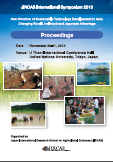Biomass Utilization of Waste Oil Palm

This presentation describes some of the collaborative research works and their findings on biomass
utilization of waste oil palm between School of Industrial Technology, Universiti Sains Malaysia (USM)
and Japan International Research Center for Agricultural Sciences (JIRCAS). Basically two kinds of
collaborations exist between the two organizations.
The first collaboration was a continuation of work based on Memorandum of Understanding (MoU)
signed in 1995 between USM and JIRCAS. This collaboration focused on the utilization of plantation
timber in Malaysia. It was then continued on the chemical composition of tropical timber. The collaboration
is still continuing and currently working on biomass of waste oil palm.
The research on biomass of waste oil palm focused on the manufacturing of binderless particleboard
from oil palm trunk, compressed panel from oil palm trunk, and the production of particleboard of oil
palm trunk with the addition of polyhydroxyalkanoates was also tried (Hashim, et al., 2012; Baskaran, et
al., 2012; Hashim, et al., 2011a; Lamaming, et al., 2013).
Several preliminary trials were done using bark, leaves, fronds, mid-parts and core-parts of the trunks
to manufacture experimental binderless particleboard panels. Binderless particleboard panels were made
with a target density of 0.80 g/cm3 and pressed at a temperature of 180?C and a pressure of 12 MPa.
Samples made from the core-parts and fronds had sufficient modulus of rupture and internal bond strength
to meet the Japanese Industrial Standards. The internal bond strength of the mid-part panels also met the
standard (Hashim, et al., 2011a). However, binderless board prepared from bark and leaves showed poor
modulus of rupture and internal bond strength. Samples from the core-parts had the lowest thickness swell
and water absorption but did not meet the above standard. Waste oil palm trunk has the potential to be used
to manufacture binderless panel products, and further study is carried out to improve the dimensional
stability of the board (Hashim, et al., 2011b). Our findings showed that the mechanical and physical
properties of such experimental panels were influenced by particle geometry, temperature and chemical
composition (Lamaming, et al., 2013; Hashim, et al., 2012).
Experimental compressed lumber from oil palm trunks were made using several parameters including
steaming time, pressure, pressure time and temperature ranging from 2 to 4 hrs, from 5 to 12 MPa, from
20 to 60 mins and from 100 to 200?C, respectively. Compression and recovery ratios of the specimens
were determined. Based on the results, the specimens were steamed for 2 hrs before they were compressed
using a pressure of 11 MPa at a temperature of 200?C for 60 mins; they resulted in optimum conditions
(Salim, et al., 2012).
The other collaboration was created by being a research counterpart in a grant from the New Energy
and Industrial Technology Development Organization (NEDO) working on basic characterization of
pressed sap, especially on the sugar content from old oil palm trunk during storage. Upon completion of
the NEDO grant, the research work is still continuing with the fund from JIRCAS on the basic
characterization of separated oil palm trunk fibers and the elucidation of sugar accumulation mechanism
during storage.
The results showed that the felled oil palm trunk contains a large quantity of sap that accounts for
approximately 70% of the whole trunk weight. The sugars existing in the sap increased remarkably after
30 days of storage, followed by a gradual decrease. The total sugar concentration in the sap increased from
83 to 153 mg ml-1, that is comparable to that of sugar cane juice. The sugars contained in the sap were
glucose, sucrose, fructose and galactose. The results indicate that old oil palm trunk could be a promising
source of sugars by proper aging, and its sap can be a good feedstock for production of bioethanol (Yamada,
et al., 2010).
We have also characterized the separated parenchyma and vascular bundle of oil palm trunk as functions of storage time. The outer parts of the trunks had a larger amount of vascular bundles than the inner and
middle parts. Moisture content of the samples from the inner part of the trunks was significantly higher
than other parts (Mhd Ramle, et al, 2012).
Oil palm waste biomass was found to be highly potential to be utilized as a raw material in related
industries. The biomass such as the trunk and the frond could be used for producing wood products. The
sap from the trunk could be used as feedstock for the production of ethanol and biogas. Oil palm biomass
waste is sustainable and continuously available throughout the year. Utilizing oil palm biomass will reduce
the pressure on the utilization of trees from forests.
| Date of issued | |
|---|---|
| Creator | Othman Sulaiman |
| Subject |
Oil palm biomass waste binderless particleboard compressed oil palm panel oil palm sap |
| Publisher | Japan International Research Center for Agricultural Sciences |
| Available Online | |
| Issue | 2013 |
| spage | 145 |
| epage | 154 |
| Rights | Japan International Research Center for Agricultural Sciences |
| Language | eng |
